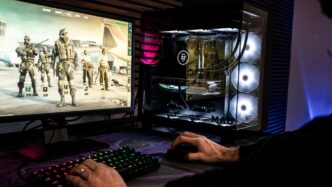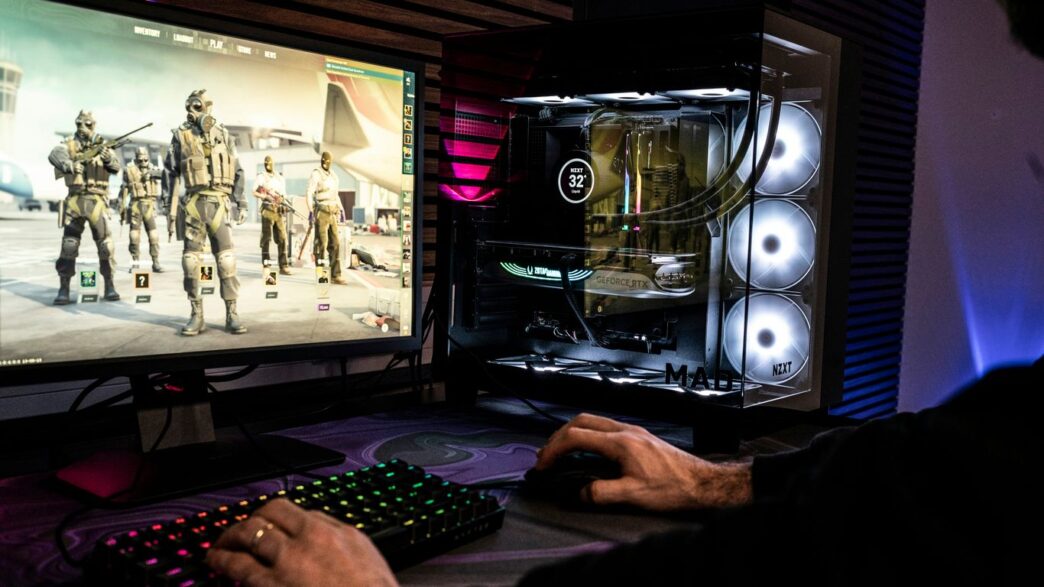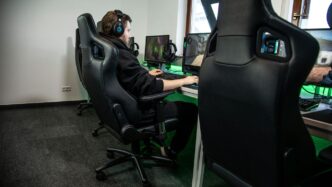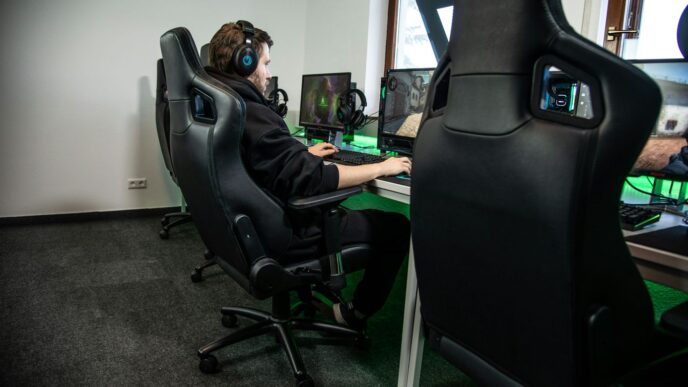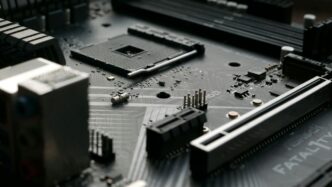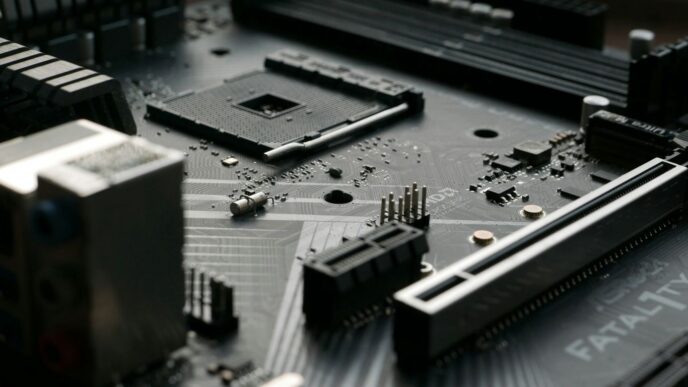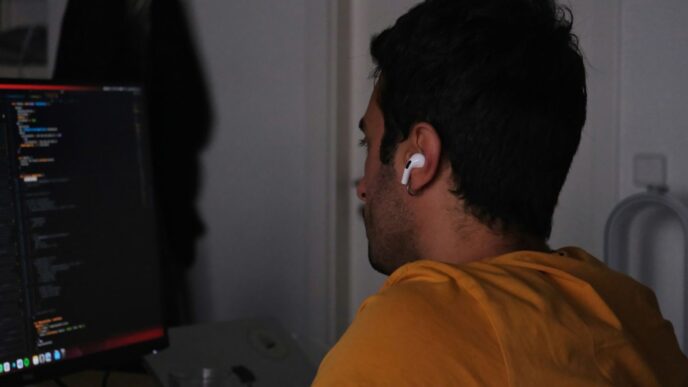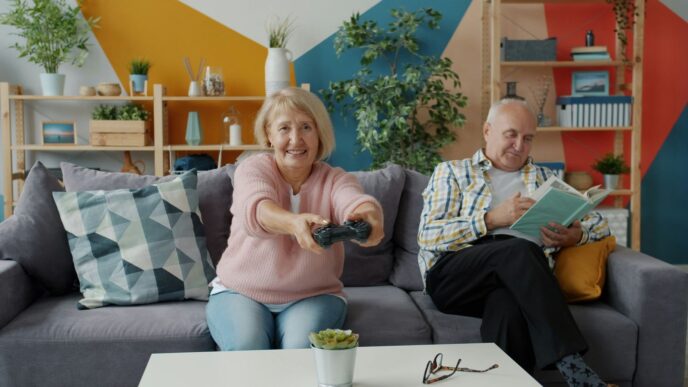Thinking about getting into PC gaming but worried about the cost? It’s totally possible to build a solid gaming PC for under $600 that can handle most popular games at 1080p. You don’t need to spend a fortune to get a good experience. We’ll look at how to pick the right parts and some ideas for builds that won’t break the bank. It’s all about smart choices to get the most bang for your buck.
Key Takeaways
- A gaming PC under $600 can provide a good 1080p gaming experience, especially for esports titles and medium settings in AAA games.
- Focus on core components like the CPU and GPU for the biggest performance gains within a tight budget.
- Consider AMD Ryzen APUs for a cost-effective solution that offers decent integrated graphics, allowing for a dedicated GPU upgrade later.
- 16GB of RAM and a 500GB NVMe SSD are recommended for smooth multitasking and fast loading times.
- Building your own PC is often cheaper and more customizable than buying a pre-built system in this price range.
Building Your Ultimate Gaming PC Under $600
Getting into PC gaming doesn’t have to cost a fortune. You might think that building a machine capable of playing today’s games smoothly means spending a lot of money, but that’s just not true anymore. With a budget of $600, you can put together a solid gaming PC that will handle popular titles at 1080p resolution without breaking a sweat. It’s all about making smart choices and focusing on what really matters for gaming performance.
Understanding the Budget Gaming PC Landscape
The world of budget gaming PCs has really opened up. Gone are the days when you needed to spend over a grand for a decent experience. Now, manufacturers and DIY builders alike are finding ways to pack more power into affordable packages. This means you can get a machine that’s not just playable, but actually enjoyable for games like Fortnite, Valorant, or even some of the newer, more demanding titles if you tweak the settings a bit. The key is understanding where to put your money for the biggest performance gains. It’s about getting the most bang for your buck, and that’s exactly what we’re going to explore.
Key Components for a Sub-$600 Rig
When you’re working with a tight budget, every component choice counts. You can’t just grab the flashiest parts; you need to be strategic. Here’s a quick rundown of what you’ll be focusing on:
- CPU (Processor): This is the brain of your PC. For gaming, you want something that can keep up without bottlenecking your graphics card. We’ll look at options that offer good performance for the price.
- GPU (Graphics Card): This is arguably the most important part for gaming. It handles all the visual processing. Finding a good balance here is critical for smooth frame rates.
- RAM (Memory): This is where your PC stores data it’s actively using. Not having enough can cause stuttering and slow performance.
- Storage (SSD/HDD): This is where your games and operating system live. An SSD makes a huge difference in loading times.
- Motherboard, Power Supply, and Case: These are the supporting cast. They need to be reliable and compatible, but often offer the most room for savings.
Balancing Performance and Price
Finding that sweet spot between performance and price is the name of the game in budget PC building. It’s a constant balancing act. For instance, you might see a CPU that’s a little more expensive but offers significantly better integrated graphics, potentially saving you from buying a dedicated graphics card right away. Or, you might opt for a slightly less powerful, but much cheaper, graphics card and invest that saved money into faster RAM or a larger SSD. We’ll be looking at configurations that make these smart trade-offs, ensuring you get a gaming experience that feels great without overspending. It’s about making informed decisions so your $600 goes as far as possible.
Essential Components For A Gaming PC Under $600
Alright, so you’re looking to build a gaming PC without spending a fortune, aiming for that sweet spot under $600. That’s totally doable, but you’ve got to be smart about where your money goes. Think of it like building a really good sandwich – you don’t need the fanciest bread if the fillings are amazing, right? We’re going to focus on the parts that actually make a difference in how your games run.
Choosing The Right CPU
The processor, or CPU, is like the brain of your computer. For a budget build, you’ve got a couple of solid options. AMD’s Ryzen APUs, like the Ryzen 5 5600G, are pretty neat because they have built-in graphics. This means you can actually play games right out of the box without needing a separate graphics card, which saves a bunch of cash. It’s a great starting point, especially for esports titles or older games. If you’re leaning towards Intel, look for something like a Core i3 or i5, but make sure it’s a model that doesn’t have integrated graphics (often marked with an ‘F’ at the end, like the i3-12100F). This way, you know you’ll be adding a dedicated graphics card later, and you’re not paying for graphics you won’t use.
Graphics Card Considerations
This is where a lot of your gaming performance comes from, so it’s important. For under $600, you’re probably looking at entry-level dedicated graphics cards. Cards like the NVIDIA GeForce GTX 1650 or the AMD Radeon RX 6400 are common finds. They’re perfectly capable of running most popular games at 1080p with medium settings, which is pretty good for this price range. If you go with an AMD APU like the Ryzen 5 5600G, its integrated Radeon graphics can handle lighter games, giving you the option to add a more powerful graphics card down the line when your budget allows. Don’t underestimate the power of integrated graphics for starting out!
RAM and Storage Essentials
- RAM (Memory): You’ll want at least 16GB of RAM. This is the amount that most modern games recommend, and it lets you multitask without your PC slowing to a crawl. Having 16GB (usually in two 8GB sticks) means you can have a game running, Discord open, and a few browser tabs without issues. DDR4 is the standard for this budget, and aiming for a speed of 3200MHz is a good balance of performance and cost.
- Storage: This is where your games and operating system live. A Solid State Drive (SSD) is a must-have. Forget those old, slow Hard Disk Drives (HDDs) for your main drive. An NVMe SSD, even a smaller 500GB one, will make your computer boot up in seconds and load games way faster. It makes a huge difference in the overall feel of using the PC. If you need more space for lots of games, you can always add a larger, cheaper HDD later for storing files, but your operating system and most-played games should be on the SSD.
Here’s a quick look at what to aim for:
| Component | Recommendation for Sub-$600 Build |
|---|---|
| CPU | AMD Ryzen 5 5600G or Intel Core i3/i5 (no integrated graphics) |
| GPU | NVIDIA GTX 1650 / AMD RX 6400 (or use APU graphics initially) |
| RAM | 16GB DDR4-3200 (2x8GB) |
| Storage | 500GB NVMe SSD |
Recommended Configurations For Gaming PCs Under $600
Alright, so you’re looking to build a gaming PC without breaking the bank, aiming for that sweet spot under $600. It’s totally doable, and honestly, pretty fun to figure out. We’ve got a few ways you can go about this, depending on what you prioritize.
AMD Ryzen APU Builds
This is a really smart way to start if you want to keep costs down initially. AMD’s Ryzen APUs, like the 5600G, have graphics built right into the processor. This means you can skip buying a separate graphics card for now. These integrated Radeon graphics are surprisingly capable for esports titles and lighter games. You can get a solid 1080p experience in games like Valorant or League of Legends. Plus, the motherboard and CPU are usually pretty affordable, leaving more room in the budget for things like faster RAM or a bigger SSD. Later on, if you want to play more demanding games, you can just add a dedicated graphics card without needing to replace the CPU or motherboard. It’s a great upgrade path.
Intel Core Builds With Dedicated GPUs
If you’re leaning towards Intel, you’ll likely pair a budget-friendly Core i3 or i5 processor with an entry-level dedicated graphics card. Think something like an Intel Core i3-12100F or an i5-12400F. These CPUs offer good performance for the price. For the graphics card, you’d be looking at options like the NVIDIA GTX 1650 or the AMD RX 6400. These cards are designed to handle 1080p gaming at medium settings in many popular titles. While not as flexible as the APU route for initial cost savings, this setup gives you a dedicated graphics solution right from the start, which can be beneficial for certain games or if you plan on doing some light content creation alongside gaming. Finding a good deal on a pre-owned graphics card can also stretch your budget further here.
Compact Mini-PC Options
Don’t underestimate the little guys! Mini-PCs can be a fantastic option if you’re tight on space or just prefer a cleaner desk setup. Many manufacturers offer pre-built mini-PCs that pack decent gaming hardware. You might find configurations with processors like the Intel NUC or AMD Ryzen-based mini-systems. While they might not offer the same level of upgradeability as a standard tower, they often come with surprisingly capable integrated graphics or even small dedicated GPUs. They’re perfect for casual gaming, esports, and general use, and they often have a sleek, modern look. Just be sure to check the specs carefully to make sure it meets your gaming needs.
Maximizing Value In Your Gaming PC Build

So, you’re trying to get the most bang for your buck with a gaming PC under $600. It’s totally doable, but you gotta be smart about where you spend your cash. It’s not just about picking the cheapest parts; it’s about finding the ones that give you the best performance for what you pay. This means looking at components that offer a great balance between price and power.
When you’re on a tight budget, every dollar counts. You might see a super-fast SSD that’s tempting, but if it eats up too much of your budget, you might end up with a weaker graphics card, which is a big no-no for gaming. It’s a bit of a puzzle, really. You want to make sure the core parts, like the CPU and GPU, are as good as they can be without breaking the bank.
Here’s a breakdown of how to think about it:
- Prioritize the GPU: For gaming, the graphics card is usually the most important piece. Try to allocate a good chunk of your budget here. Even a slightly older, but still capable, GPU can make a huge difference compared to a brand-new, but weaker, one.
- CPU Matters, But Don’t Overspend: You need a decent CPU to keep up with the GPU, but you don’t necessarily need the absolute top-of-the-line model. Look for CPUs that offer good gaming performance without costing a fortune. Sometimes, a slightly older generation CPU can be a fantastic deal.
- RAM and Storage: Find the Sweet Spot: Aim for at least 16GB of RAM. More is nice, but 16GB is generally enough for most games today. For storage, an SSD is a must for fast loading times. A 500GB or 1TB NVMe SSD is usually a good compromise between speed, capacity, and price. You can always add more storage later if needed.
- Don’t Forget the Power Supply (PSU): A reliable PSU is super important. Don’t skimp here! A cheap, low-quality PSU can actually damage your other components. Look for a reputable brand with enough wattage for your build, plus a little extra for future upgrades. An 80 Plus Bronze or Gold certification is a good sign of efficiency and reliability.
- Case and Motherboard: Function Over Flash: While fancy RGB cases and motherboards look cool, they often cost more. For a budget build, focus on cases with good airflow and a motherboard that supports your chosen CPU and has the ports you need. You can always add more flair later. A solid motherboard choice can be found on this page.
Thinking about these things will help you build a PC that not only fits your budget but also plays the games you want to play smoothly. It’s all about making smart choices so you get the best gaming experience possible without overspending.
Achieving 1080p Gaming Performance

So, you’ve put together a rig that fits the under $600 budget, and now you’re wondering what kind of gaming experience you can actually expect. The good news is, 1080p gaming is totally within reach for most modern titles, especially if you’re not aiming for every single graphical setting cranked to the absolute max.
The goal here is smooth, enjoyable gameplay without breaking the bank. This means finding that sweet spot where your chosen components work well together to push decent frame rates at a 1920×1080 resolution.
Smooth Gameplay Expectations
When we talk about smooth gameplay, we’re generally looking for frame rates that hover around 60 frames per second (fps) or higher. For many games, especially those that aren’t super graphically demanding or if you’re willing to tweak settings a bit, hitting this target is very doable. For example, a build featuring something like an AMD Ryzen APU or an Intel CPU paired with a budget-friendly dedicated GPU can often manage this. You might see frame rates in the 40-60 fps range in more demanding titles on medium to high settings. It’s not always about maxing everything out; it’s about having a playable and fun experience. For a more in-depth look at what kind of performance you can get, check out this guide on building a gaming PC for around $600 building a gaming PC for around $600.
Optimizing Settings For Popular Titles
Not every game needs Ultra settings. Honestly, most people can’t tell the difference between High and Ultra in the heat of the moment. So, what can you do?
- Start with Presets: Most games offer graphics presets like Low, Medium, High, and Ultra. Begin with High and see how it runs. If it’s not smooth enough, drop to Medium.
- Tweak Individual Settings: Some settings have a bigger impact on performance than others. Things like shadows, anti-aliasing, and ambient occlusion can often be turned down without a huge visual hit.
- Resolution Scaling: If a game supports it, lowering the internal rendering resolution slightly and then upscaling can sometimes give you a big performance boost with a minimal visual compromise.
- V-Sync and Frame Limiters: Use these to prevent screen tearing and keep your frame rates consistent, even if it means capping them below your PC’s maximum potential.
The Role Of The GPU In 1080p
The graphics card (GPU) is arguably the most important piece for 1080p gaming. It’s the component that does the heavy lifting when it comes to rendering all those pretty pixels on your screen. For a sub-$600 build, you’re likely looking at either integrated graphics on an AMD APU (like a Ryzen 5 5600G) or a dedicated entry-level to mid-range GPU.
Here’s a general idea of what to expect:
| GPU Type | Typical Performance at 1080p (Medium-High Settings) | Notes |
|---|---|---|
| AMD APU Graphics | 30-50 fps | Good for lighter esports titles and older games. |
| Entry-Level GPU | 50-70+ fps | Capable of handling most modern games with some settings adjustments. |
| Mid-Range Budget | 60-90+ fps | Excellent for 1080p, often allowing for higher settings. |
While an APU can get you gaming without a separate graphics card, saving money upfront, a dedicated GPU will almost always provide a significant performance uplift. Choosing a card like the AMD Radeon RX 6600 or an Nvidia RTX 3050 (if you can find one in budget) can make a world of difference for your 1080p experience.
Pre-Built vs. DIY Gaming PCs Under $600
So, you’re looking to snag a gaming PC without breaking the bank, specifically aiming for that sweet spot under $600. This brings up a big question: should you build it yourself, or is it better to buy one that’s already put together? Both paths have their ups and downs, and honestly, it really depends on what you’re looking for.
Advantages Of Building Your Own
Building your own PC can feel like a big undertaking, but it’s often the way to go if you want the most bang for your buck. You get to pick every single part, from the case that looks cool to the specific brand of RAM. This means you can really focus your budget on what matters most for gaming. Plus, you learn a ton about how computers work, which is super handy if something goes wrong later or if you want to swap out a part for an upgrade down the line. It’s like building with LEGOs, but for grown-ups, and the end result is a machine tailored exactly to your needs. You’re also likely to save a good chunk of cash compared to buying a similar setup pre-assembled. It’s a bit more effort upfront, but the control and savings are pretty significant.
When A Pre-Built Makes Sense
Now, if the idea of picking out motherboards and wrestling with cables sounds like a nightmare, a pre-built PC might be your best bet. These machines come ready to go right out of the box. You don’t have to worry about compatibility issues or putting anything together. For folks who just want to jump straight into gaming without any fuss, this is a huge plus. Manufacturers assemble and test these systems, so you usually get a reliable machine with a warranty. It’s the convenience factor, you know? You pay a bit more for that ease, but for some people, that’s totally worth it. If you’re not interested in the technical side of things, a pre-built gaming PC is a solid choice.
Finding Deals On Gaming PCs
Whether you go the DIY route or opt for pre-built, keeping an eye out for deals is key when you’re on a tight budget. Sales pop up all the time, especially around holidays. Sometimes, you can find a pre-built system on sale that’s priced so competitively, it’s hard to beat even if you built it yourself. On the flip side, if you’re building, you can often snag individual components for less during these sale periods. It’s all about timing and a bit of searching. Keep an eye on tech websites and retailers; you might just find that perfect gaming PC under $600 sale you’ve been hoping for.
Wrapping Up Your Budget Gaming Journey
So, building a solid gaming PC for under $600 isn’t some impossible dream. We’ve seen that with smart part choices, you can absolutely get a machine that handles popular games at 1080p without breaking the bank. Whether you go with an AMD APU to start and add a graphics card later, or find a good deal on an Intel build with a dedicated GPU, there are options out there. Remember, 16GB of RAM and an SSD are pretty important for a smooth experience, even on a budget. It’s all about getting the most bang for your buck so you can start playing without feeling like you spent a fortune. Happy gaming!
Frequently Asked Questions
What kind of games can I play on a PC under $600?
With a PC under $600, you can expect to play popular games like Fortnite, Valorant, and Minecraft smoothly. For newer, more demanding games, you might need to lower the graphics settings to get a good frame rate, but you can still enjoy them!
Is it better to build my own PC or buy a pre-built one for under $600?
Building your own PC usually gives you more bang for your buck. You get to choose exactly what parts go in, often saving money compared to a pre-built system. Plus, you’ll learn a lot about computers!
What are the most important parts to focus on for a budget gaming PC?
The most important parts are the CPU (the brain) and the GPU (the graphics card). For a budget build, you’ll want a good balance between these two to make sure your games run well.
How much RAM do I need for a gaming PC under $600?
For a gaming PC in this price range, 16GB of RAM is the sweet spot. It’s enough to run most games smoothly and allows you to have other programs like a web browser open at the same time without issues.
What kind of storage should I get for a budget gaming PC?
An SSD (Solid State Drive) is a must-have. Even a 500GB SSD will make a huge difference in how fast your computer starts up and how quickly games load. NVMe SSDs are even faster if your budget allows.
Can I upgrade a PC under $600 later on?
Yes, absolutely! Many budget builds use standard parts that are easy to swap out later. You can often upgrade your graphics card or add more storage down the line to keep your PC performing well without buying a whole new machine.

